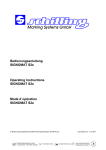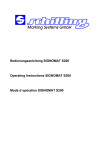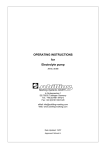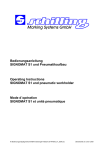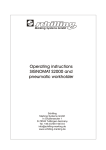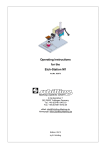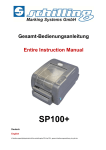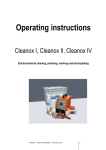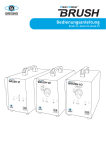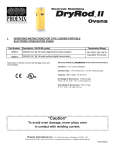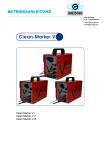Download Bedienungsanleitung SIGNOMAT S200 Operating Instructions
Transcript
Bedienungsanleitung SIGNOMAT S200 Operating Instructions SIGNOMAT S200 Mode d´opération SIGNOMAT S200 K:\Bedienungsanltg\Signiertechnik\BA-Erstellung\S200-Bedanl_DE-GB-FR.doc Schilling Marking Systems GmbH In Grubenäcker 1 DE-78532 Tuttlingen +49 (0)7461 9472-0 +49 (0)7461 9472-20 Überarbeitet am: 11.04.2014 www.schilling-marking.de [email protected] Bedienungsanleitung SIGNOMAT S200 Operating instructions SIGNOMAT S200 Mode d´opération SIGNOMAT S200 Updated: 04-2014 2 VORWORT Sehr geehrter Kunde, Sie haben mit der Anschaffung der SCHILLING Beschriftungsanlage SIGNOMAT S200 eine gute Wahl getroffen, und wir danken Ihnen für das Vertrauen, das Sie unserem Produkt entgegenbringen. Ihre Anlage würdigt dieses Vertrauen, doch stellt sie von Anfang an eine Bedingung: Sie wünscht immer, auch unter den rauesten Bedingungen, anständig behandelt zu werden. Deshalb gehört diese Bedienungsanleitung in die Hände des Bedienungspersonals. Es wäre verfehlt, diese im Betriebsarchiv ein verstaubtes Dasein fristen zu lassen. Wir haben deshalb versucht Ihnen alle Hinweise und Informationen zu geben, die für die Bedienung, Wartung und Überwachung der Anlage notwendig sind. Bitte lesen Sie diese Anleitung VOR DER INBETRIEBNAHME der Anlage aufmerksam durch und machen Sie sich mit ihr vertraut. Wenn Sie genau allen Anweisungen folgen, werden Sie Zeit sparen und Verlusten vorbeugen, und Sie werden mit der Leistung der Anlage nach Jahren noch voll zufrieden sein. Wir wünschen Ihnen erfolgreiche Arbeit und beste Ergebnisse mit Ihrer SCHILLING-Anlage. Vielen Dank für Ihre Aufmerksamkeit und einen guten Start! INTRODUCTION Dear Customer, You have made a good choice by purchasing a SIGNOMAT S200 Marking System. Thank you for your trust in our product. Your system will honour this trust, but there will be one condition to satisfy right from the onset: The system should always be treated with respect, even under the most ardent of conditions. Therefore, these Operating Instructions should be kept with operators. It would be a mistake to have these Operating Instructions rot away under heaps of dust. We have therefore endeavoured to give you all the recommendations and information necessary for operating, servicing and monitoring your system. Please read these Instructions carefully PRIOR TO COMMISSIONING the system in order to become familiar with them. Following these Instructions precisely will save you time and prevent losses, and you will still be fully satisfied with the system’s performance in years to come. We wish you success in your work and optimal results by employing your SCHILLING System. Thank you for your attention and have a good start! INTRODUCTION Cher client, Vous avez fait un bon choix avec l’achat d’un système de marquage SIGNOMAT S200 de SCHILLING. Nous vous remercions pour votre confiance en nos produits. Votre machine honore votre confiance, mais demande une condition pour toujours fonctionner parfaitement. Elle souhaite, d’être manipulée avec précaution, même dans des conditions difficiles. Par conséquent, ce mode d’opération appartient aux mains de l’employeur. Ce serait une erreur, de laisser ce mode d’opération atterrir aux archives! C’est pourquoi, nous avons essayé de vous donner toutes les recommandations et informations qui sont nécessaires à l’emploi, au service, et contrôle de votre machine. Lisez, s’il vous plaît, attentivement ces instructions AVANT LA MISE EN MARCHE de la machine, et mettez vous en confiance. Si vous suivez exactement ces instructions, vous économiserez du temps et éviterez des faires des erreurs. Vous serez satisfait de la performance de votre machine pendant des années. Nous vous souhaitons du succès et de bons résultats avec votre machine SCHIILLING. Nous vous remercions pour votre attention et bon départ! Schilling Marking Systems GmbH In Grubenäcker 1 DE-78532 Tuttlingen +49 (0)7461 9472-0 +49 (0)7461 9472-20 www.schilling-marking.de [email protected] Bedienungsanleitung SIGNOMAT S200 Operating instructions SIGNOMAT S200 Mode d´opération SIGNOMAT S200 Inhalt: Contents: Sommaire: 1. 2. 3. 4. 1. 2. 3. 4. 1. 2. 3. 4. Sicherheitshinweise 3 Bestimmungsgemäßer Gebrauch 3 Technische Daten 4 Herstellerinformation 4 -Hersteller 4 -Änderungen 4 -Vertraulichkeit 4 5. Maschine, Bedienelemente Signomat S200 5/6 6. Transport, Montage und Inbetriebnahme 6 7. Arbeiten mit dem Signomat S200 7 8. Arbeiten mit dem Zubehör 7 9. Verbesserung der Signierung 8 10.Kurzschluss und Überlast 8 11.Wartung und Pflege 8 Bestellwesen 9 -Stempel + Schablonen 9 -Elektrolytverwendungsliste/ Chemikalien 10/11 Diese Bedienungsanleitung ist eine wichtige Grundlage für fachgerechte Bedienung und Wartung der Geräte. Sorgen Sie deshalb dafür, dass die Bedienungsanleitung für den Bediener jederzeit verfügbar ist. Safety instructions 3 Scope of application 3 Technical data 4 Manufacturer information 4 -Manufacturer 4 -Alterations 4 -Confidentiality 4 5. Machine, control elements Signomat S200 5/6 6. Transport, installation and start-up 6 7. Working with the Signomat S200 7 8. Working with the accessories 7 9. Improving the marking results 8 10.Short circuit and overcharge 8 11.Servicing and maintenance 8 Ordering 9 -Stamps + stencils 9 -Use of Electrolytes/Chemicals 12/13 These operating instructions form is an important prerequisite for the proper operation and maintenance of the equipment. Therefore, please ensure that the operating instructions are kept available for the operating personnel at all times. Updated: 04-2014 3 Consignes de sécurité 3 Utilisation réglementaire 3 Caractéristique techniques 4 Informations concernant le fabricant 4 -Fabricant 4 -Modifications 4 -Confidentiel 4 5. Machine, éléments de commande Signomat S200 5/6 6. Transport, montage et mise en service 6 7. Opération avec le Signomat S200 7 8. Opération avec les accessoires 7 9. Amélioration du marquage 8 10. Court-circuit et surcharge 8 11. Entretien et maintenance 8 Commandes 9 -Tampon + pochoir 9 -Utilisation des Électrolytes/ Produits électrochimiques 14/15 Ce mode d´utilisation contient les informations essentielles pour assurer l´utilisation et l´entretien des appareils, conformément aux exigences techniques. Veillez à ce que ce mode d´opération soit toujours à disposition de l´utilisateur. 1) Safety instructions 1) Consignes de sécurité 1) Sicherheitshinweise Berühren Sie bei eingeschaltetem Gerät nie direkt mit dem Handstempel die Kontaktplatte des Signomat S200, sonst gibt es einen Kurzschluss. Sollte dies doch einmal geschehen sein, sehen Sie im Abschnitt „Kurzschluss“ nach, was zu tun ist. Der SIGNOMAT S200 ist bei bestimmungsgemäßem Gebrauch ungefährlich. Trotzdem sollten Sie im Gebrauch der Chemikalien einige Dinge beachten: Benutzen Sie Gummihandschuhe. Die Augen mit Schutzbrille vor Elektrolyt, Neutralyt und Konservat schützen. Sollten die Augen trotzdem einmal Kontakt mit den Chemikalien haben, spülen Sie die Augen sofort gründlich mit viel klarem Wasser, suchen Sie einen Arzt auf. Bei Haut- und Kleiderkontakt mit den Chemikalien sind diese sofort mit Wasser zu reinigen. Essen und Trinken am Signierarbeitsplatz ist verboten. Vor der Nahrungsaufnahme sind die Hände zu waschen. Halten Sie Kinder vom Gerät fern. SIGNOMAT S200 nur in trockenen Räumen betreiben. Das Gerät kann mit einer Netzspannung von 230 Volt oder 115 Volt betrieben werden. Die Umschaltung erfolgt automatisch beim Einschalten. Halten Sie explosive Gase vom Gerät fern. Vor dem Öffnen des Gerätes Netzstecker ziehen. Quetsch- und Scherstellen sind weitestgehend beseitigt. 2) Bestimmungsgemäßer Gebrauch Die Geräte dienen ausschließlich der Signierung metallischer Gegenstände. Die Funktion und ein reproduzierbares Ergebnis ist nur mit Schilling Zubehör gewährleistet. Never allow the manual stamp to touch the contact plate of the Signomat S200 directly when the machine is switched on, as this results in a short circuit. Should this happen, please refer to the section „Short circuit“ for instructions. When used properly, the SIGNOMAT S200 is operationally safe. Still, a few points should be noted for the handling of chemicals: Use rubber gloves. Eyes must be protected against electrolyte, neutralyte and preserving agent. Should eyes come into contact with the chemicals, immediately rinse eyes thoroughly with clear water and contact a physician. Do not swallow electrolyte, neutralyte and preserving agent. Should electrolyte be swallowed, immediately drink a large glass of clear water and contact a physician. Should skin or clothing come into contact with the chemicals, rinse immediately with water. Eating or drinking at the workplace is prohibited. Hands must be washed before eating. Keep children clear of the machine. Use the Signomat S200 in dry locations only. This machine can be operated with 230 Volt or 115 Volt. The adaptation is carried out automatically when switching on the device. Keep explosive gases clear of the machine. Disconnect the mains plug before opening the machine. Most points at which danger of injury exist have been eliminated. 2) Scope of applications The equipment is designed exclusively for marking metallic objects. Proper function and a reproducible result are guaranteed only when Schilling accessories are used. Lorsque l´appareil est en marche, ne jamais mettre en contact le tampon manuel avec la plaque porte-contact du Signomat S200, sinon il y a un court-circuit. En cas de courtcircuit, consultez le paragraphe „courtcircuit“ afin de savoir procéder. Le SIGNOMAT S200 est sans dangers dans la mesure où il est utilisé correctement. Cependant, vous devez prendre certaines remarques en considération lors de l´utilisation des produits électrochimiques: Utilisez des gants en caoutchouc. Portez des lunettes protectrices afin de protéger vos yeux contre les effets de l´électrolyte, du neutralyte et du produit de conservation. Dans le cas où des produits électrochimiques vous pénètrent dans les yeux, rincez les grandes eaux claires et consultez un médecin. Ne pas avaler de l`électrolyte, du neutralyte ou du produit de conservation. Si vous avez avalé de l´électrolyte, buvez un grand verre d´eau claire et consultez un médecin. Si les produits électrochimiques entrent en contact avec la peau ou les vêtements, nettoyez aussitôt avec de l´eau. Il est interdit de manger et de boire au poste de travail de marquage. Se laver les mains avant de consommer de la nourriture. L´électrolyte peut être éliminée dans les eaux d´évacuation. Tenir les enfants à distance de l´appareil. Mettre l´appareil Signomat S200 en exploitation uniquement dans les locaux secs. La machine fonctionne avec 230 Volt ou 115 Volt. Le basculement s’effectue automatiquement pendant la mise en marche de la machine. Tenez les gaz explosifs à distance de l´appareil. Avant d´ouvrir l´appareil, retirer la prise secteur. Dans une large mesure, les risques de coupure et d´écrasement ont été éliminés.. 2) Utilisation réglementaire Les appareils servent exclusivement à marquer les objets métalliques. L´appareil fonctionne et garantit un bon résultat de reproduction uniquement lorsqu´on utilise les accessoires de la société Schilling. Schilling Marking Systems GmbH In Grubenäcker 1 DE-78532 Tuttlingen +49 (0)7461 9472-0 +49 (0)7461 9472-20 www.schilling-marking.de [email protected] Bedienungsanleitung SIGNOMAT S200 Operating instructions SIGNOMAT S200 Mode d´opération SIGNOMAT S200 Updated: 04-2014 4 3) Technische Daten 3) Technical data 3) Caractéristiques techniques Typ: SIGNOMAT S200 Fabrikations Nummer: siehe Typenschild Baujahr: siehe Typenschild Abmessungen: BxHxT 260 x 95 x 250 mm Betriebsspannung: 230 V/115 V 50/60 Hz Signierspannung: 12 V Signierart: hell/dunkel Nennleistung: 40 VA Gewicht: 3,9 kg Sicherung: 5 A autom. Stromüberwachung 1,00 A Schmelzsicherung 5x20mm Geräuschpegel: 20 dB Type: SIGNOMAT S200 Factory number: see nameplate Year of construction: see nameplate Dimensions: WxHxL 260 x 95 x 250 mm Operating voltage: 230 V/115 V 50/60 Hz Marking voltage: 12 V Type of mark: light/dark Rate power: 40 VA Weight: 3.9 kg Fusing: 5 A autom. power control 1.00 A fuse 5x20 mm Noise level: 20 dB Type: SIGNOMAT S200 Numéro de fabrication: voir plaquette Année de fabrication: voir plaquette Dimensions: LxHxL 260 x 95 x 250 mm Tens. d´exploitation: 230 V/115 V 50/60 Hz Tension de marquage: 12 V Type de marquage: foncé/clair Puissance nominale: 40 VA Poids: 3,9 kg Fusible: 5 A contrôle autom. du courant fusible 1,00 A 5x20 mm Niveau de bruit: 20 dB 4) Herstellerinformation 4) Manufacturer information 4) Informations concernant le fabricant Schilling Marking Systems GmbH In Grubenäcker 1 DE-78532 Tuttlingen Deutschland Telefon: +49 (0)7461 9472-0 Fax: +49 (0)7461 9472-20 eMail: [email protected] Homepage: www.schilling-marking.de Schilling Marking Systems GmbH In Grubenaecker 1 DE-78532 Tuttlingen Germany Telephone: +49 (0)7461 9472-0 Facsimile: +49 (0)7461 9472-20 email: [email protected] Web: www.schilling-marking.com Schilling Marking Systems GmbH In Grubenaecker 1 DE-78532 Tuttlingen Allemagne Téléphone: +49 (0)7461 9472-0 Télécopie: +49 (0)7461 9472-20 eMail: [email protected] Page d’accueil: www.schilling-marking.com Änderungen: Alterations: Modifications: Technische Änderungen vorbehalten. Ihre Maschine kann sich deshalb in einigen Details von den Abbildungen in diesem Handbuch unterscheiden. Dies nimmt jedoch keinen Einfluss auf die Bedienung der Maschine. Die mit “ * “ gekennzeichneten Positionen sind optional und nur bei entsprechender Bestellung im Lieferumfang enthalten. Technical alterations reserved. Your machine may therefore deviate in details from the illustrations in the manual. This does not affect the operation of the machine. The “ * ” marked positions are optional and have to be ordered separately. Sous réserve de modifications techniques. Il se peut que, pour quelques détails, votre machine soit différente du modèle représenté dans les illustrations de ce manuel. Cela n´a cependant aucun effet sur l´utilisation de la machine. Les positions marquées avec “ * “ ne sont que des options et ne sont comprises dans la livraison uniquement si spécifier dans la commande. Vertraulichkeit: These operating instructions are to be treated confidentially. They have been provided only for use in your operation by authorized persons. The transfer of this document to third parties is prohibited and may result in damages claims. All rights, including the right to translation, are reserved. No portion of these operating instructions may be reproduced in any form or processed by means of electronic systems without written permission by Schilling. Diese Bedienungsanleitung ist vertraulich zu behandeln. Sie ist ausschließlich zur Verwendung in Ihrem Betrieb durch befugte Personen bestimmt. Die Überlassung an Dritte ist verboten und verpflichtet zum Schadenersatz. Alle Rechte, auch die der Übersetzung, sind vorbehalten. Kein Teil dieser Bedienungsanleitung darf in irgendeiner Form ohne schriftliche Genehmigung des Hauses Schilling reproduziert oder unter Verwendung elektronischer Systeme verarbeitet werden. Schilling Marking Systems GmbH In Grubenäcker 1 DE-78532 Tuttlingen Confidentiality: +49 (0)7461 9472-0 Confidentiel: Ce mode d´opération doit être traité confidentiellement. Il est exclusivement destiné à une utilisation interne, dans votre entreprise, par du personnel en ayant l´autorisation. Il est interdit de le remettre à un tiers sous peine de dommages intérêts. Tous droits réservés, y compris ceux de traduction. Il est interdit de traiter par systèmes électroniques ou de reproduire une partie de ce mode d´opération, sous quelque forme que se soit, sans l´autorisation écrite de la société Schilling. +49 (0)7461 9472-20 www.schilling-marking.de [email protected] Bedienungsanleitung SIGNOMAT S200 Operating instructions SIGNOMAT S200 Mode d´opération SIGNOMAT S200 Updated: 04-2014 5 9.2 5.2 1 2 7 9.0 9.1 8 4.2 3 5 4 11 10 13 8 7 20 18 14 17 Schilling Marking Systems GmbH In Grubenäcker 1 DE-78532 Tuttlingen +49 (0)7461 9472-0 +49 (0)7461 9472-20 www.schilling-marking.de [email protected] Bedienungsanleitung SIGNOMAT S200 Operating instructions SIGNOMAT S200 Mode d´opération SIGNOMAT S200 5) Maschine, Bedienelemente SIGNOMAT S200 Die Hauptteile und Bedienungselemente finden Sie auf Seite 5 abgebildet. 1 2 3 4 4.2 5 5.2 7 8 9.0 9.1 9.2 10 11 13 14 15 16 17 18 19 20 Gelbe Leuchte „Betriebsbereitschaft“ Grüne Leuchte „Signierstrom an“ Rote Leuchte „Überstromanzeige“ Umschalter für den Betriebsmodus Anzeige des Betriebsmodus Auswahl hell / dunkel (Tabelle beachten) Anzeige der Stromart Rote Anschlussbuchse für das Werkstück Schwarze Anschlussbuchse für den Signierstempel Signierzeit vergrößern Signierzeit verkleinern Anzeige der Signierzeit (0,1 bis 9,9 Sekunden und unendlich) Ein/Aus - Schalter Anschlussbuchse für den Fußschalter Typenschild Handstempel Kontaktklemme Rotes Kabel Schwarzes Kabel Fußschalter mit Kabel und Stecker* Netzkabel Filz und O-Ring 6) Transport, Montage und Inbetriebnahme Bewahren Sie die Verpackung auf und verwenden Sie diese zum Transport wieder. Achten Sie darauf, dass alles Zubehör mitverpackt wird und die Flüssigkeitsflaschen sorgfältig verschlossen sind. Ausgelaufene Flüssigkeiten sollten unter Verwendung von Gummihandschuhen, Putztuch und Wasser aufgewischt werden. Beachten Sie dabei die Sicherheitshinweise unter Kapitel 1. Schließen Sie den Signomat mit dem Netzkabel 19 an die Netzspannung an. Schalten Sie das Gerät auf der Rückseite mit dem Schalter 10 ein. Das Gerät stellt sich automatisch auf die anliegende Netzspannung um, erkennt alle angeschlossene Komponenten und stellt den entsprechenden Betriebsmodus ein. Die Lampe 1 muss leuchten. Stecken Sie das schwarze Kabel 17 in den Stempel 14 und in die schwarze Buchse 8 des Gerätes. Wählen Sie mit dem Taster 5, ob Sie hell oder dunkel signieren möchten. Jedes Drücken der Taste schaltet die Stromart um. Sie wird im Display 5.2 angezeigt. Wählen Sie mit dem Taster 4 den Signiermodus aus. Jedes Drücken der Taste schaltet in einen anderen Modus um. Er wird im Display 4.2, grafisch (Handstempel oder Handstempel mit Fußschalter), angezeigt. Prüfen Sie, ob der Stempel 14 mit Filz und O-Ring 20 ausgestattet ist. Wählen Sie in Anlehnung an die beiliegende Tabelle „Elektrolytverwendungsliste“ den für Ihr Werkstück-Metall richtigen Elektrolyten. Die Signierdauer wird mit der Taste 9.0 vergrößert und mit der Taste 9.1 verkleinert. Die eingestellte Signierzeit kann auf dem Display 9.2 abgelesen werden. Der Bereich liegt zwischen 0,1 – 9,9 s (empfohlene Signierzeit 1x4s, oberflächenbehandelte z.B. brünierte Teile 2x4s). Befeuchten Sie den Filz mit etwas Elektrolyt. Schilling Marking Systems GmbH In Grubenäcker 1 DE-78532 Tuttlingen 5) Machine, control elements Signomat S200 The main parts and control elements are illustrated on page 5. 1 2 3 4 4.2 5 5.2 7 8 9.0 9.1 9.2 10 11 13 14 15 16 17 18 19 20 Yellow lamp „ready for operating“ Green lamp „marking current on“ Red lamp „marking current too high“ Working mode selection Display of working mode Current selection light / dark (see table) Display of current selection Red connector socket for workpiece Black connector socket for stamp Increment marking time Decrement marking time Display of marking time (0.1 to 9.9 seconds and unlimited) On/off switch Connection socket for foot switch Nameplate Manual stamp Contact clamp Red cable Black cable Foot switch with cable and plug* Mains cable Felt piece and O-ring 6) Transportation, installation and start up Save packaging and use for later transportation. Ensure that all accessories are packed with the machine, and that bottles containing fluids are sealed carefully. Rubber gloves, a cloth and water should be used to clean up spilled fluids. Please refer to the safety instructions given in Section 1. Connect the Signomat to mains voltage by means of the mains cable 19. Switch the machine on at the rear by means of switch 10. The machine switches automatically to the local mains voltage, recognizes the connected components and adjusts to the corresponding operating mode. Lamp 1 should light up. Plug the black cable 17 into the stamp 14 and into black socket 8 of the machine. Use switch 5 to choose either light or dark marking. Each push of the key changes the type of current. It is shown on the display 5.2. Use switch 4 to select the marking modus. Each push of the key changes over to a different modus. It is shown as a graphic on the display 4.2: (Hand stamp or hand stamp with foot switch). Check whether stamp 14 is equipped with felt piece and O-ring 20. Select the correct electrolyte for the metal of the work piece according to the attached table “Use of Electrolytes”. Use switch 9.0 to extend the marking time and switch 9.1 to reduce it. The selected marking time is shown on the display 9.2. It may range from 0.1 to 9.9 s (recommended marking time is 1x4s, or 2x4s for surface treated parts e.g. black oxide). Moisten the felt piece with electrolyte. +49 (0)7461 9472-0 Updated: 04-2014 6 5) Machine, éléments de commande Signomat S200 Les composants principaux et les éléments de commande sont représentés à la page 5. 1 2 3 4 4.2 5 5.2 7 8 9.0 9.1 9.2 10 11 13 14 15 16 17 18 19 20 Voyant jaune, état de marche Voyant vert, courant pour le marquage enclenché Voyant rouge «surintensité de courant» Sélection du mode d’opération Indication du mode d’opération Commutateur clair/foncé (consulter le tableau) Indication du mode courant Douille de raccordement rouge pour la pièce à marquer Douille de raccordement noire pour le tampon Augmenter le temps de marquage Diminuer le temps de marquage Indication pour la durée de marquage (0,1 à 9,9 secondes et illimité) Interrupteur marche/arrêt Douille de raccordement pour l´interrupteur à pédale. Plaque signalétique Tampon manuel Pince de contact Câble rouge Câble noir Interrupteur à pédale avec câble et prise* Cordon électrique Feutre et anneau torique d´étanchéité 6) Transport, montage et mise en service: Conservez l´emballage et réutilisez le pour le transport. Prenez garde à ce que tous les accessoires soient emballés avec l´appareil et que la bouteille de produits fluides soit fermée avec précaution. Essuyer les produits fluides qui se sont échappés en utilisant des gants en plastique, un chiffon et de l´eau. Respectez les consignes de sécurité présentées au chapitre 1. Raccordez le Signomat à la tension secteur en utilisant le câble secteur 19. Enclenchez l´appareil au moyen de l´interrupteur 10 se trouvant au dos de l´appareil. La machine s’adapte automatiquement à la tension de réseau locale, reconnaît tous les composants connectés et ajuste le mode d’opération correspondant. La lampe 1 doit s´allumer. Branchez le câble noir 17 au tampon 14 dans la douille noire 8 de l´appareil. Sélectionnez au moyen de l´interrupteur 5 le type de marquage que vous voulez effectuer, clair ou foncé. Chaque pression sur la touche change le type de marquage qui est indiqué sur l’écran 5.2. Sélectionnez au moyen de l’interrupteur 4 le mode de marquage. Chaque pression sur la touche change le mode de marquage qui est indiqué sur l’écran 4.2 comme un symbole (tampon manuel ou tampon manuel avec interrupteur à pédale). Contrôlez si le tampon 14 est équipé de feutre et de l´anneau torique d´étanchéité 20. A l´aide du tableau „utilisation des électrolytes“ ci-joint, sélectionnez l´électrolyte adaptée au métal de votre pièce à marquer. Augmentez la durée de marquage avec la touche 9.0 et diminuez la durée de marquage avec la touche 9.1. La durée sélectionnée est indiquée sur l’écran 9.2. Le gamme est entre 0,1 et 9,9 s (durée de marquage recommandée 1x4s, surface traitée p. ex. pièce brunir noire 2x4s). Humidifiez le feutre avec un peu d´électrolyte. +49 (0)7461 9472-20 www.schilling-marking.de [email protected] Bedienungsanleitung SIGNOMAT S200 Operating instructions SIGNOMAT S200 Mode d´opération SIGNOMAT S200 Updated: 04-2014 7 7) Arbeiten mit dem Signomat S200 7) Working with the Signomat S200 7) Opération avec le Signomat S200 Wählen Sie in Anlehnung an die beiliegende Tabelle „Elektrolytverwendungsliste“ den für Ihr Metallwerkstück richtigen Elektrolyt (empfohlene Signierzeit 1x4s, oberflächenbehandelte z.B. brünierte Teile 2x4s). Benetzen Sie den Filz am Stempel und die Schablone vorsichtig und gleichmäßig mit dem richtigen Elektrolyt. Der Filz muss gleichmäßig befeuchtet sein, darf aber nicht tropfen. Drücken Sie den Handstempel senkrecht von oben mit der ganzen Fläche gleichmäßig auf die Schablone. Wenn Sie ohne Fußschalter arbeiten, schaltet sich der Signierstrom jetzt von selbst ein. Die grüne Lampe 2 leuchtet auf. Der Signiervorgang ist beendet wenn ein kurzes akustisches Signal ertönt und die grüne Lampe 2 abgeschaltet ist. Wenn Sie den Fußschalter verwenden und ihn an die Buchse 11 angeschlossen haben, fließt erst dann der Signierstrom, wenn der Stempel mit dem Werkstück Kontakt hat und Sie den Fußschalter 18 betätigt haben. Wischen Sie Elektrolytreste mit dem neutralytfeuchten Tuch ab. Korrosionsanfällige Metalle werden mit Neutralyt N2 neutralisiert und mit Konservat K1 geschützt. Welcher Elektrolyt für Ihren Werkstoff geeignet ist, entnehmen Sie bitte der beiliegenden Tabelle. Select the correct electrolyte for the metal of the workpiece according to the provided table “Use of Electrolytes” (recommended marking time 1x4s, surface treated parts e.g. black oxide 2x4s). Carefully and evenly moisten the felt piece on the stamp and the stencil with the selected electrolyte. The felt must be evenly moistened with the electrolyte and should not drip. Position the moistened marking stencil with the desired text on the workpiece. Press the manual stamp downward vertically, ensuring that the entire surface contacts the stencil evenly. If foot switch is not used, the marking current is now automatically switched on. Green lamp 2 lights up. The marking procedure has been completed when a short acoustic signal is given and green lamp 2 is extinguished. If foot switch is used and connected to socket 11, marking current is switched on only after the stamp has made contact with the workpiece and foot switch 18 has been activated. Wipe away remaining electrolyte using a cloth moistened with neutralyte. Metals which corrode are neutralised by neutralyte N2 and protected by preserving agent K1. The electrolyte suitable for the workpiece material used is listed in the provided table. Um Oxidationsprobleme (Rost) zu vermeiden, empfehlen wir dringend, dass Sie mit den Chemikalien sehr sauber arbeiten. Vor allem dürfen Sie nicht das Werkstück mit den Händen berühren, wenn Elektrolytreste an Ihren Händen sind (Elektrolytverschleppung). Bei Stählen mit hohem Kohlenstoffgehalt ist ein sauberes Neutralisieren, Ultraschallreinigen und/oder Überziehen mit einem Ölfilm oder unserem Konservat dringend angeraten. In order to avoid oxidation (rust), we urgently recommend that chemicals are handled with extreme care. Above all, never touch the workpiece with your hands when traces of electrolyte are on your hands (electrolyte may be carried over). For steel with high carbon content, thorough neutralization, cleaning by ultrasound and/or coating with a film of oil or a preserving agent is highly recommended. A l´aide du tableau „utilisation des électrolytes“ ci-joint, sélectionnez l´électrolyte adaptée au métal de votre pièce à marquer (durée de marquage recommandée 1x4s, surface traitée p. ex. pièce brunir noire 2x4s). Humidifiez avec précaution et régulièrement le feutre du tampon et le pochoir avec l´électrolyte correcte. Le feutre doit être humidifié régulièrement avec l´électrolyte mais il ne doit pas goutter. Ensuite, placez le pochoir de marquage humide dans la position souhaitée, votre texte étant placé sur la pièce. Appliquez le tampon manuel verticalement, à partir du haut, sur toute la surface, en l´appuyant régulièrement sur le pochoir. Si vous travailler sans l´interrupteur à pédale le courant pour le marquage maintenant s’enclenche automatiquement. La lampe verte 2 s´allume. Lorsqu´une brève tonalité retentit et que la lampe verte 2 s´éteint, le procédé de marquage est achevé. Si vous avez utilisé l´interrupteur à pédale 18 et que vous l´avez raccordé à la douille 11, le courant pour le marquage s´enclenche lorsque le tampon est en contact avec la pièce à marquer et que vous avez actionné l´interrupteur à pédale 18. Essuyez les restes d´électrolyte avec un chiffon humidifié de neutralyte. Les métaux sensibles à la corrosion sont neutralisés avec neutralyte N2 et protégés en appliquant du produit de conservation K1. Le tableau ci-contre, vous indique quelle sorte d´électrolyte est adaptée à la matière Première que vous utilisez. Bei Schablonen, die größer als der Handstempel sind, wenden Sie das Streichverfahren an: Stellen Sie eine Signierzeit größer 9.9s oder kleiner 0,1s ein, arbeitet das Gerät mit Dauerstrom und dieses Symbol erscheint im Display „OO“. Statt mit dem Handstempel unbeweglich auf die Schablone und das Werkstück zu drücken, streichen Sie gleichmäßig mit dem Handstempel in eine Richtung über die Schablone von einem Ende zum anderen. Erarbeiten Sie so die Geschwindigkeit, die für eine gute Signierung bei einmaligem Streichen benötigt wird. Wenn Sie die Signierung dunkler wünschen, können Sie mehrmals über die Schablone und das Werkstück streichen. 8) Arbeiten mit dem Zubehör Die Kontaktklemme 15 hilft Ihnen, wenn Sie sperrige Werkstücke signieren wollen. Klemmen Sie die Kontaktklemme am Werkstück an, stecken Sie das rote Kabel 16 auf die Kontaktklemme und die rote Buchse 7 und signieren Sie das Werkstück wie gewohnt mit Schablone und Handstempel. Kundenspezifische Aufbaueinheiten sind als Zubehör extra erhältlich und erleichtern Ihnen das passgenaue Signieren, weil die Schablone und das Werkstück vom Aufbau exakt gehalten werden. Legen Sie das Werkstück in die Werkstückaufnahme (auswechselbar und gegebenenfalls kundenspezifisch) der Aufbaueinheit und justieren Sie mit den Einstellschrauben die Schablone. Schließen Sie die Werkstückaufnahme des Aufbaues mit dem roten Kabel 16 an die rote Buchse 7 an und signieren Sie wie gewohnt mit dem Handstempel das Werkstück. Schilling Marking Systems GmbH In Grubenäcker 1 DE-78532 Tuttlingen Apply the stroking method for stencils which are larger than the manual stamp. Set the marking time either on more than 9.9s or less than 0.1s to operate the machine with continuous current. This is shown with the symbol „OO“ on the display. Instead of pressing the manual stamp on the stencil and workpiece without movement, press the manual stamp on the stencil while moving in one direction from one end to the other. Determine the speed required to obtain satisfactory marking results with one stroke in this manner. If the marking should be darker, the stamp may be stroked over the stencil and workpiece several times. 8) Working with accessories Contact clamp 15 is provided for marking bulky objects. Clamp the contact clamp onto the workpiece, connect the red cable 16 to the contact clamp and red socket 7, and mark the workpiece using stencil and manual stamp as described above. Add-on assemblies constructed according to customer specification are additionally available as accessory equipment, and facilitate exact marking by holding the stencil and workpiece in a precisely defined position. Place the workpiece in the workpiece receiver (exchangeable and constructed according to customer specification on request) of the add-on assembly and adjust the stencil using the adjusting screw. Connect the workpiece receiver on the add-on assembly to the red socket 7 using the red cable 16, and mark the workpiece using the manual stamp as described above. +49 (0)7461 9472-0 Afin d´éviter des problèmes d´oxydation (rouille), nous vous recommandons de travailler très proprement avec les produits électrochimiques. Surtout, vous ne devez pas toucher la pièce à marquer avec les mains lorsque celle-ci présente encore des restes d´électrolyte (entraînement de l´électrolyte). Pour les aciers à haute teneur en carbone, il est fortement recommandé d´effectuer une neutralisation propre, d´effectuer un nettoyage par ultrasons et/ou d´appliquer une pellicule d´huile ou de produit de conservation. Concernant les pochoirs de dimensions supérieures à celles du tampon, utilisez le procédé d´application: Ajustez le temps de marquage >9.9s ou <0.1s pour travailler avec courant permanent («infini»). Il est indiqué sur l’écran avec le symbole „OO“. Au lieu d´appuyer le pochoir de manière fixe sur le pochoir et sur la pièce à marquer, appliquez le tampon manuel régulièrement dans une direction sur le pochoir d´une extrémité à l´autre. Réglez donc de cette manière la vitesse qui est nécessaire pour garantir un marquage correct en effectuant une seule application. Si vous désirez obtenir un marquage plus foncé, vous pouvez effectuer plusieurs fois une application sur le pochoir et la pièce à marquer. 8) Opérations avec les accessoires La pince de contact 15 vous permet de marquer des pièces de grandes dimensions. Serrez la pince de contact sur la pièce à marquer, branchez le câble rouge 16 à la pince de contact et dans la douille rouge 7 et marquez comme d´habitude la pièce avec le pochoir et avec le tampon manuel. Les unités d´extension spécifiques à vos besoins sont disponibles en tant qu´accessoires spéciaux et vous facilitent la précision de marquage, étant donné que le pochoir et la pièce à marquer sont maintenus de manière exacte par l´unité. Placez la pièce à marquer sur le support de pièces (remplaçable et le cas échéant spécifique à vos besoins) de l´unité d´extension et ajustez le pochoir au moyen des vis de réglage. Raccordez le support de pièces à l´unité au moyen au câble rouge 16 à la douille rouge 7 et marquez la pièce comme d´habitude avec le tampon manuel. +49 (0)7461 9472-20 www.schilling-marking.de [email protected] Bedienungsanleitung SIGNOMAT S200 Operating instructions SIGNOMAT S200 Mode d´opération SIGNOMAT S200 Updated: 04-2014 8 9) Verbesserung der Signierung 9) Improving marking results 9) Amélioration du marquage Vor dem ersten Signieren ist die Schablone ohne Strom mit Elektrolyt benetzen. Ein trockener Filz verhindert den Stromfluss, die Signierung wird sehr schlecht. Eingetrocknetes Elektrolyt und Neutralyt versalzen die Maschine, dadurch ist der Stromfluss behindert. Die Signierung wird schlecht. Deshalb ist reinigen mit klarem Wasser täglich Pflicht. Die Schablonen müssen regelmäßig und behutsam zwischen zwei Fingern unter Wasser gesäubert werden, da sie durch Metallrückstände verschmutzt werden. Auch den Stempel und die Werkstückaufnahme regelmäßig mit Wasser reinigen. Bei starker Verschmutzung ist sie mit Schilling Schleifreiniger (Art.Nr: 22.165) zu behandeln. Sorgen Sie dafür, dass Ihnen für Ihr Metall der richtige Elektrolyt zur Verfügung steht (siehe beiliegende Elektrolytverwendungsliste auf Seiten 10/11). Bestimmte Materialien, z.B. Hartmetall, müssen mit Konservat K1 (Art.Nr: 22.111) geschützt werden. Kleine Flächen durch einfache Andrucktechnik signieren. Große Flächen von Hand mit Abstreichtechnik signieren. Die Schablone darf sich nicht zu stark erwärmen, da sie sonst vorzeitig verschleißt oder der Elektrolyt verdampft. Bei Signierzeiten ab 5s treten Temperaturen von 120°C und mehr in der Schablone auf. Das Signierbild wird schlecht und die Schablone „wellt“ sich. Die Schablone muss ausgetauscht werden. Im Normalbetrieb haben die Langzeitschablonen eine Standzeit von 2000-3000 Signierungen. Gedunkelte Filze regelmäßig ersetzen. Der Filz dunkelt umso mehr, je größer das Signierbild ist. Before the first marking procedure, moisten the stencil with electrolyte when current is switched off. Dry felt impedes current conduction, and the resulting mark is extremely poor. Dried electrolyte and Neutralyt result in salt deposits in the machine; this also impedes current conduction, causing poor marking results. For this reason, daily rinsing with clear water is necessary. Stencils soiled by metallic residue must be cleaned carefully and at regular intervals. To do this, hold the stencil carefully between two fingers under water and clean. The stamp and work piece receiver must also be cleaned with water at regular intervals. In case of extreme soiling, clean with Schilling abrasive cleaner (Art. No: 22.165). Ensure that the electrolyte suitable for the metal to be marked is on hand (see attached list Use of Electrolytes pages 12/13). Certain materials, e.g. hard metal, must be protected by preserving agent K1 (Art. No: 22.111). Mark small surfaces using the simple pressing method. Mark larger surfaces manually using the stroking method. To avoid premature wear and to prevent the electrolyte from evaporating, the stencil should not be heated excessively. Using marking times over 5s causes the material of the stencil to gum up to temperatures of over 120°C. This causes poor marking results and stencil turns “wavy”. The stencil must than be replaced. In normal operation, the stencils with long service life are good for 2000-3000 marking procedures. Felt which has darkened must be replaced at regular intervals. Darkening of the felt increases with the size of the marking image. Avant le premier marquage, humidifier le pochoir avec l´électrolyte, sans courant. Un feutre sec empêche le flux du courant, le marquage est très mauvaise qualité. De l´électrolyte et du neutralyte séchés sur la machine, empêche le courant de s´écouler. Le marquage est alors de mauvaise qualité. Pour cette raison, il faut effectuer un nettoyage quotidien avec de l´eau claire. Il faut nettoyer régulièrement et avec précaution les pochoirs en les maintenant sous l´eau avec deux doigts, étant donné qu´ils peuvent être salis par des restes de métal. Nettoyer également sous l´eau le tampon et le support de pièces. Dans le cas où ils sont très sales, les traiter avec le gomme nettoyante Schilling (Art.No.: 22.165). Veillez à disposer de l´électrolyte appropriée pour votre métal (voir tableau sur pages 14/15). Certains matériaux, comme par ex. le métal dur, doivent être protégés avec un produit de conservation K1 (Art.No.: 22.111). Marquer les petites surfaces en utilisant une technique d´application simple. Marquer les surfaces de grandes dimensions, à la main, en utilisant la technique d´application. Le pochoir ne doit pas se réchauffer trop fortement sinon il s´use prématurément ou l´électrolyte s´évapore. Des temps de marquage dépassant 5s comportent un échauffement dépassant 120°C sur le pochoir et le tissu du pochoir colle. Le marquage est alors de mauvaise qualité. Il faut remplacer le pochoir. Dans des conditions d´exploitation normales, les pochoirs de longue durée ont un temps d´utilisation permettant d´effectuer 2000-3000 marquages. Remplacer régulièrement les feutres encrassés. Plus le marquage est grand, plus le feutre s´encrasse. 10) Kurzschluss und Überlast The Signomat is equipped with an electronic controller of the marking current. In case of a short circuit or overcharge, it switches off the marking current within fractions of a second and triggers an acoustic an optical warning signal. After five seconds, the machine is ready to be used for the next marking. The board is equipped with a mains fuse. Have the machine checked by Schilling in case that this fuse is burnt. Generally check the mains connection. Should no marking power be available, check whether the cables are kinked and therefore interrupted. If so, immediately replace cables with original Schilling replacement cables. 10) Short circuits and overcharge 10) Court-circuit et surcharge 11) Servicing and maintenance Le Signomat a un contrôle électronique du courant de marquage. Il coupe le courant de marquage depuis une fraction d’une seconde en cas d’un court-circuit ou d’un surcharge. Un signal acoustique et optique est déclenché. Après 5 seconds, la machine est prête pour le prochain marquage. Sur la platine se trouve un fusible de secteur. En cas d’une combustion de ce fusible, le Signomat doit être contrôlé par Schilling. En générale, il doit contrôler le raccordement de réseau. S´il n´y a pas de courant pour le marquage, contrôlez si les câbles ne sont pas pliés ou rompus; il faut alors aussitôt remplacer les câbles par des câbles de remplacement d´origine, de la société Schilling. 11) Wartung und Pflege Signomat: 11) Entretien et maintenance Signomat: The Signomat is maintenance-free. The stamp, the felt piece and contact plate or workpiece receiver must be cleaned thoroughly with water after each working day. Stencils have a service life of 2000-3000 marking procedures. Replace the stamp when it shows signs of excessive wear. Replace the marking felts daily. Signomat: Der Signomat besitzt eine elektronische Signierstromüberwachung. Sie schaltet, bei Kurzschluss oder Überlast, den Signierstrom innerhalb von Sekundenbruchteilen ab und löst ein akustisches und optisches Warnsignal aus. Nach fünf Sekunden ist das Gerät für die nächste Signierung wieder einsatzbereit. Eine Netzsicherung befindet sich auf der Platine. Sollte diese durchgebrannt sein muss das Gerät im Werk überprüft werden. Prüfen Sie grundsätzlich die Netzverbindung. Sollte kein Signierstrom fließen, ist zu prüfen, ob die Kabel durch Abknicken unterbrochen sind; dann sind die Kabel sofort durch original Schilling Ersatzkabel auszutauschen. Der Signomat ist wartungsfrei. Den Stempel, den Filz und die Kontaktplatte oder die Werkstückaufnahme nach jedem Arbeitstag mit Wasser gründlich reinigen. Schablonen haben eine Standzeit von bis zu 3000 Signierungen. Den Stempel bei starker Abnutzung ersetzen. Filze täglich gegen neue austauschen. Schilling Marking Systems GmbH In Grubenäcker 1 DE-78532 Tuttlingen +49 (0)7461 9472-0 Le Signomat n´a pas besoin d´entretien. A la fin de chaque journée de travail, nettoyer à fond avec de l´eau le tampon, le feutre et la plaque porte-contact ou le support de pièces. Les pochoirs ont un temps d´utilisation permettant d´effecteur jusqu´à 3000 marquages. En cas de forte usure, remplacer le tampon. Remplacez les feutres quotidiennement. +49 (0)7461 9472-20 www.schilling-marking.de [email protected] Bedienungsanleitung SIGNOMAT S200 Operating instructions SIGNOMAT S200 Mode d´opération SIGNOMAT S200 Handstempel + Stempel Bestellwesen Ordering manual stamps + stamps Commandes tampon manuel + tampon 34. Maschinenstempel Machine stamp Tampon mécanique A B L B flach/flat/à plat D D .800 .801 .811 .802 .803 .804 F H H H Breite Width Largeur 15 mm 15 20 25 30 35 40 .805 .806 .807 .808 .809 .810 45 50 55 60 80 100 B L B L Sondermaße auf Anfrage. Other dimensions available on request. Dimensions spéciales sur demande. konvex/convex/convexe flach/flat/à plat D H H B I L Handstempel mit integrierter Elektrolytversorgung, o. Abb. Bestell-Nr. 29.001 Manual stamp with integrated electrolyte supply, not pictured. Ordering no. 29.001. Tampon manuel avec alimentation en électrolyte intégrée, pas d´image. No. de cde. 29.001. 7.5 G B konkav/concave/concave E Höhe Height Hauteur 25 mm Bestell-Nr. Länge in mm Bestell-Nr. Länge in mm Ordering no. Length in mm Ordering no. Length in mm No de cde. Longeur en mm No de cde. Longeur en mm H L B Standardmaße Standard dimensions Dimensions standard C H H 9 Deutsch: Wählen Sie den Handstempel oder den Maschinenstempel aus und notieren Sie sich die ersten beiden Zahlen als Bestellnummer-Anfang. Aus unterstehender Tabelle bestimmen Sie die Maße des Stempels, wählen eine der Stempelformen A bis I aus und ergänzen die Bestellnummer. Bei Stempel B, C, E, F, G und H und geben Sie zusätzlich noch den gewünschten Durchmesser an. Bestell-Beispiel: 34.806 C 8 = Maschinenstempel / Maße 50x15x25mm / Form C / konkav für Durchmesser 8 mm. English: Select the manual stamp or machine stamp and note the first two numbers; these are the first two digits of the ordering number. Use the table provided below the determine the dimensions of the stamp; select a stamp shape from A to I and complete the ordering number. Please specify the desired diameter for stamp shapes B, C, E, F, G and H. Example: 34.806 C 8 = machine stamp / dimensions 50x15x25mm / shape C / concave for 8 mm diameter Francais: Choisissez le tampon ou le tampon mécanique et notez les deux premiers chiffres au début du numéro de commande. Le tableau ci-dessous vous permet de déterminer les dimensions du tampon, choisissez une des formes de tampons de A à I et complétez le numéro de commande. Pour les tampons B, C, E, F, G et H et indiquez également le diamètre souhaité. Example de commande: 34.806 C 8 = timbre mécanique / dimensions 50x15x25mm / forme C / concave pour un diamètre de 8 mm. Handstempel Manual stamp Tampon manuel 29. Updated: 04-2014 H H H abgesetzt/offset décalé < 15 x 15 15 bikonkav/biconcave/biconcave 15 Automatische Filzverstellung ohne Stempel o. Abb. Bestell-Nr. 11.130. Automatic felt piece adjustment without stamp, not pictured. Ordering no. 11.130. Réglage automatique du feutre sans tampon, pas d´image. No. de cde. 11.130. Manuelle Filzverstellung ohne Stempel, o. Abb. Bestell-Nr. 11.120. Manual felt piece adjustment without stamp, not pictured. Ordering no. 11.120. Réglage manuel du feutre sans tampon, pas d ´image. No. de cde. 11.120. 1 Repro Preis X € / Price for repros X € / Prix repro X € 2 Fotosatz einzeilig Y € / Price for phototypesetting, one line Y €/ Photocomposition, prix Y € pour une ligne (mehrzeilig auf Anfrage/several lines available on request/ plusieurs lignes, sur demande) 3 Signierschablone Preis Z € / Price for marking stencil Z € / Pochoir à marquer, prix Z € 4 Nachbestell-Nr. Preis Z € / Price for subsequent orders Z € / No. de commande supplémentaire, prix Z € Schablonen Bestellwesen Ordering stencils Commandes pochoirs Normalschablonen / Standards stencils / Pochoirs normaux 65 m m 39,5 + /- 1 m m Bestell-Nr. Ordering no. No de cde. 3 2 4 In Grubenäcker 1 D-78532 Tuttlingen Tel.: + 49 (0)7461 9472-0 15 m m 1 123456 b a Sonderschablonen mit speziellen Rahmungen auf Anfrage Special stencils with special frames available on request Pochoirs spéciaux avec encadrement spécial sur demande Schilling Marking Systems GmbH In Grubenäcker 1 DE-78532 Tuttlingen FO 40 FO 50 FO 60 FO 80 FO 100 a a a b b b 40 50 60 80 100 30 40 50 70 90 Stempelgröße (Maße in mm) Stamp size (dimensions in mm) Dimensions du tampon (dimensions en mm) < 30 < 40 < 50 < 70 < 90 Kurzzeitschablonen / stencil with short service life / Pochoir de courte durée Bestell-Nr. Ordering no. No de cde. Maße Dimensions Dimensions 22.160.S 22.160.6 22.161BE 22.162.1 22.5118.13 BS 60x180mm 180x270mm BE 60mmx10m 78mmx30m perforiert/perforated/perforé Klischeeband/stamp tape/cassette de ruban stencil 18 mm breit/wide/large, 3,0m lang/long/longue Klischeeband 24mm breit/wide/large, 3,5m lang/long/longue Klischeeband 36mm breit/wide/large, 3,0m lang/long/longue Klischeeband für Drucker/printer SP100+ 95mmx20m 22.5124.13 22.3636.13 22.4100.13 +49 (0)7461 9472-0 +49 (0)7461 9472-20 www.schilling-marking.de [email protected] Bedienungsanleitung SIGNOMAT S200 Operating instructions SIGNOMAT S200 Mode d´opération SIGNOMAT S200 Updated: 04-2014 10 Elektrolytverwendungsliste Art.Nr. Elektrolyt Einstellung Gerät/ Spannung Schilling Elektrolyte sind das Ergebnis aus vielen Jahren der Forschung und Entwicklung. Sie sind sorgfältig zusammengestellt zum Signieren von unterschiedlichsten Metallen und Oberflächen. Elektrolyte sind pH abgestimmte Salzlösungen, die bei sachgemäßer Anwendung vollständig unbedenklich für Haut, Kleidung, Teile und Umgebungsausrüstung sind. Alle Sicherheitsdatenblätter für unsere Gemische/Zubereitungen stehen jederzeit aktuell zum Herunterladen auf unserer Webseite www.schilling-marking.de zur Verfügung. Aluminium 22.038 AE38 hell/24V Aluminium (meisten Legierungen) 22.038 AE38 hell/24V Aluminium mit hohem Magnesium- oder Siliziumgehalt 22.025 AE25 hell/24V 22.038 AE38 hell/24V Beryllium Blei & Legierungen Bronze 22.001 22.030 22.037 22.025 AE1 AE30 AE37 AE25 Brünierte (schwarz oxidierte) Stähle 22.026 AE26 Brünierte Teile 22.026 AE26 dunkel/12V dunkel/12V dunkel/12V dunkel/12V hell/dunkel/ 12V hell/dunkel 12V 22.030 AE30 dunkel/12V 22.005 22.001 22.005 22.035 22.001 22.035 22.035 22.010 22.036 22.010 22.035 22.026 22.037 22.001 22.037 22.025 22.030 22.035 22.037 22.037 22.025 22.037 22.025 22.030 22.037 22.025 22.038 22.035 22.037 22.025 22.001 22.035 22.030 22.003 22.035 AE5 AE1 AE5 AE35 AE1 AE35 AE35 AE10 AE36 AE10 AE35 AE26 AE37 AE1 AE37 AE25 AE30 AE35 AE37 AE37 AE25 AE37 AE25 AE30 AE37 AE25 AE38 AE35 AE37 AE25 AE1 AE35 AE30 AE3 AE35 dunkel/12V dunkel/12V dunkel/12V dunkel/12V dunkel/12V dunkel/12V dunkel/12V dunkel/12V dunkel/12V dunkel/12V dunkel/12V dunkel/12V dunkel/12V dunkel/12V dunkel/12V dunkel/12V dunkel/12V dunkel/12V dunkel/12V dunkel/12V dunkel/12V dunkel/12V dunkel/12V dunkel/12V dunkel/12V dunkel/12V dunkel/12V dunkel/12V dunkel/12V dunkel/12V dunkel/12V dunkel/12V dunkel/12V dunkel/12V dunkel/12V Material, Legierungen, Branche Chrom, verchromte Teile Chrom, verchromte Zierteile Discaloy Eisen Gold & vergoldete Teile Hartmetall Hastelloy Haynes 25 Inconnel Inconnel 625 Inconnel 718 & 750 Karbide Kobaltlegierungen Kupfer Kupferlegierungen Kupfernickel Messing Monel Neusilber Nickel & Legierungen Nickel, chemisch Schilling Marking Systems GmbH In Grubenäcker 1 DE-78532 Tuttlingen +49 (0)7461 9472-0 pH-Wert / Anmerkungen ca. 2,0 vor Nachbehandlung einige Sekunden bis Einfärbung warten ca. 5,0 / schwarz nicht möglich außer Füllung mit Lack ca. 2,0 / Tiefensignieren VOR dem Eloxieren (minimum 0,05mm) ca. 1,5 / für Serienfertigung geeignet ca. 3,0 ca. 1,5 ca. 5,0 ca. 1,6 / Einstellung: hell & dunkel (event. im Wechsel) ca. 1,6 / Einstellung: hell & dunkel (event. im Wechsel) ca. 3,0 / Einstellung: hell & dunkel (event. im Wechsel) ca. 2,0 ca. 1,5 / für Serienfertigung geeignet ca. 2,0 ca. 7,0 / pH-neutral, korrosionsarm ca. 1,5 / für Serienfertigung geeignet ca. 7,0 / pH-neutral, korrosionsarm ca. 7,0 / pH-neutral, korrosionsarm ca. 1,5 / für Serienfertigung geeignet ca. 8,0 / pH-neutral, sehr korrosionsarm ca. 1,5 / für Serienfertigung geeignet ca. 7,0 / pH-neutral, korrosionsarm ca. 1,6 / ohne Neutralisation/Reinigung ca. 1,5 ca. 1,5 / für Serienfertigung geeignet ca. 1,5 ca. 5,0 ca. 3,0 ca. 7,0 / pH-neutral, korrosionsarm ca. 1,5 ca. 1,5 ca. 5,0 ca. 1,5 ca. 5,0 ca. 3,0 ca. 1,5 ca. 5,0 ca. 2,0 ca. 7,0 / pH-neutral, korrosionsarm ca. 1,5 ca. 5,0 ca. 1,5 / für Serienfertigung geeignet ca. 7,0 / pH-neutral, korrosionsarm ca. 3,0 ca. 2,0 ca. 7,0 / pH-neutral, korrosionsarm +49 (0)7461 9472-20 www.schilling-marking.de [email protected] AE35 AE1 AE1 AE37 AE35 AE25 AE35 AE1 AE35 AE36 AE33 AE1 AE34 AE35 dunkel/12V dunkel/12V dunkel/12V dunkel/12V dunkel/12V dunkel/12V dunkel/12V dunkel/12V dunkel/12V dunkel/12V dunkel/12V dunkel/12V dunkel/12V dunkel/12V ca. 7,0 / pH-neutral, korrosionsarm ca. 1,5 / für Serienfertigung geeignet ca. 1,5 / für Serienfertigung geeignet ca. 1,5 ca. 7,0 / pH-neutral, korrosionsarm ca. 5,0 ca. 7,0 / pH-neutral, korrosionsarm ca. 1,5 / für Serienfertigung geeignet ca. 7,0 / pH-neutral, korrosionsarm ca. 8,0 / pH-neutral, sehr korrosionsarm ca. 7,0 / pH-neutral, korrosionsarm ca. 1,5 / für Serienfertigung geeignet ca. 4,0 ca. 7,0 / pH-neutral, korrosionsarm AE7 dunkel/12V ca. 7,0 / pH-neutral, korrosionsarm AE35 dunkel/12V ca. 7,0 / pH-neutral, korrosionsarm AE36 AE33 AE35 AE20 AE36 AE35 AE1 AE33 AE35 AE36 AE10 AE38 dunkel/12V dunkel/12V dunkel/12V dunkel/12V dunkel/12V dunkel/12V dunkel/12V dunkel/12V dunkel/12V dunkel/12V dunkel/12V dunkel/12V 22.037 AE37 dunkel/12V 22.004 22.033 22.010 22.033 22.035 22.026 22.010 22.037 22.010 22.035 22.026 AE4 AE33 AE10 AE33 AE35 AE26 AE10 AE37 AE10 AE35 AE26 dunkel/12V dunkel/12V dunkel/12V dunkel/12V dunkel/12V dunkel/12V dunkel/12V dunkel/12V dunkel/12V dunkel/12V dunkel/12V ca. 8,0 / pH-neutral, sehr korrosionsarm ca. 7,0 / pH-neutral, korrosionsarm ca. 7,0 / pH-neutral, korrosionsarm ca. 1,5 ca. 8,0 / pH-neutral, sehr korrosionsarm ca. 7,0 / pH-neutral, korrosionsarm ca. 1,5 / für Serienfertigung geeignet ca. 7,0 / pH-neutral, korrosionsarm ca. 7,0 / pH-neutral, korrosionsarm ca. 8,0 / pH-neutral, sehr korrosionsarm ca. 1,5 / für Serienfertigung geeignet ca. 2,0 ca. 1,5 / wenig Elektrolyt und kurze Signierzeiten (1-1,5s) ca. 7,0 / pH-neutral, korrosionsarm ca. 7,0 / pH-neutral, korrosionsarm ca. 1,5 / für Serienfertigung geeignet ca. 7,0 / pH-neutral, korrosionsarm ca. 7,0 / pH-neutral, korrosionsarm ca. 1,6 / ohne Neutralisation/Reinigung ca. 1,5 / für Serienfertigung geeignet ca. 1,5 ca. 1,5 / für Serienfertigung geeignet ca. 7,0 / pH-neutral, korrosionsarm ca. 1,6 Art.Nr. Nickel, vernickelte Messing & Kupferteile 22.035 22.001 Nickel, vernickelte Stahl- & Aluteile 22.001 Nickel, Silber 22.037 22.035 Nickel, Silber 22.025 Nitraloy 22.035 Stähle, rostfrei 22.001 22.035 22.036 Stähle, chir. Instrumente 22.033 22.001 22.034 22.035 Stähle, Lebensmittelindustrie, flexible 22.007 chir. Katheter (Sonden) Stähle, verchromte Zierteile 22.035 (Werbemittel), Baustähle 22.036 Stähle, Werkzeugstähle & hochleg. 22.033 22.035 Stähle, gehärtet und ungehärtet 22.020 Stähle, Baustahl, korrosionsanfällig 22.036 22.035 Stähle bis 1.4021 / 1.4310 22.001 22.033 Stähle, CrCo Stähle, Stähle ab 1.4310 22.035 Stähle, mit niedrigem Kohlenstoffgehalt 22.036 22.010 22.038 Titan Werkzeugstähle Werkzeugstähle, hochleg. & härtbar Wolfram Zink & verzinkte Teile Zinn Zirkonium 11 Einstellung Gerät/ Spannung Material, Legierungen, Branche Updated: 04-2014 Elektrolyt Bedienungsanleitung SIGNOMAT S200 Operating instructions SIGNOMAT S200 Mode d´opération SIGNOMAT S200 pH-Wert / Anmerkungen Bei pH-neutralen Elektrolyten wird die Oxidation (Verbindung mit Sauerstoff) nach Ende der Signierzeit sofort gestoppt. Daher werden diese Elektrolyte als „korrosionsarm“ bezeichnet. Zumindest bei hochlegierten Stählen (Legierungsbestandteile ≥10%) wie z.B. Werkstoffe für chirurgische Instrumente 1.4021 oder 1.4310 (Edelstahl) kann daher eventuell auf eine Nachbehandlung mit Neutralyt verzichtet werden. Das Oxidationsverhalten nach dem Signieren muss jedoch bei jeder Anwendung einzeln geprüft und validiert werden. Eine Gewährleistung für Schäden von korrodierten Teilen übernehmen wir in keinem Fall. Beim Signieren mit AC (Wechselstrom) muss das Signiergerät auf „DUNKEL“ eingestellt sein. Beim Signieren mit DC (Gleichstrom) muss das Signiergerät auf „HELL“ eingestellt sein. Das Signieren mit AC (Wechselstrom) ist bei den meisten Anwendungen anwendbar. Hier muss das Signiergerät auf DUNKEL eingestellt sein. Schilling Marking Systems GmbH In Grubenäcker 1 DE-78532 Tuttlingen +49 (0)7461 9472-0 +49 (0)7461 9472-20 www.schilling-marking.de [email protected] Bedienungsanleitung SIGNOMAT S200 Operating instructions SIGNOMAT S200 Mode d´opération SIGNOMAT S200 Updated: 04-2014 12 Die Eigenschaften einer Signierung mit AC sind: Farbe: schwarz Konturschärfe: gut Tiefe: gering (ca. 3-5 µm/4s Signierzeit) Beim Signieren von Aluminium wird bei allen Anwendungen grundsätzlich mit DC (Gleichstrom) gearbeitet. Hier muss das Signiergerät auf „HELL“ umgestellt werden. Beim Signieren von brünierten, vergoldeten oder anderen Oberflächen muss ebenfalls mit DC (Gleichstrom) gearbeitet werden und das Signiergerät auf „HELL“ eingestellt sein. Mit Gleichstrom wird die Oberflächenbeschichtung durchbrochen und das Grundmaterial signiert. Bei diesen Anwendungen kann auch ein Wechsel zwischen Gleich- und Wechselstrom sinnvoll sein um mit Gleichstrom zunächst die Oberfläche zu durchdringen und die „helle“ Einfärbung anschließend mit Wechselstrom an gleicher Stelle schwarz zu signieren. Die Eigenschaften einer Signierung mit DC sind: Farbe: klar Konturschärfe: unscharf Tiefe: tiefer (ca. 10 µm/4s Signierzeit) Schilling Marking Systems GmbH In Grubenäcker 1 DE-78532 Tuttlingen +49 (0)7461 9472-0 +49 (0)7461 9472-20 www.schilling-marking.de [email protected] Bedienungsanleitung SIGNOMAT S200 Operating instructions SIGNOMAT S200 Mode d´opération SIGNOMAT S200 Updated: 04-2014 13 Use of Electrolytes ItemNo Electrolyte Power unit setting/ voltage The Schilling Electrolytes are the result of many years of research and development. The composition of the electrolytes has been harmonized exactly to the various metals and surfaces. Electrolytes are salt solutions with specific pH values that do not cause any harm to the skin, clothes or surroundings when used appropriately. All up-to-date safety data sheets for our mixtures / preparations are freely available for download on our website at www.schilling-marking.de. Aluminium 22.038 AE38 light/24V Aluminium (most alloys) 22.038 AE38 Aluminium with high magnesium or silica 22.025 content AE25 22.038 AE38 Beryllium 22.001 AE1 Black oxide 22.026 AE26 22.030 AE30 Black oxide steels 22.026 AE26 Brass 22.037 22.025 22.037 22.025 22.035 22.005 22.001 22.005 22.035 22.037 22.037 22.025 22.037 22.025 22.030 22.037 22.025 22.001 22.035 22.010 22.035 22.037 22.001 22.037 22.025 22.030 22.035 22.010 22.036 22.030 22.038 22.035 22.001 22.035 22.030 AE37 AE25 AE37 AE25 AE35 AE5 AE1 AE5 AE35 AE37 AE37 AE25 AE37 AE25 AE30 AE37 AE25 AE1 AE35 AE10 AE35 AE37 AE1 AE37 AE25 AE30 AE35 AE10 AE36 AE30 AE38 AE35 AE1 AE35 AE30 Material, alloys, branch Bronze Carbides Chrome plate Chrome plate (decorative) Cobalt alloys Copper Copper alloys Copper nickel CuZn alloys Discaloy Gold & gold plate Hastelloy Haynes 25 Inconnel Inconnel 625 Inconnel 718 & 750 Iron Lead & alloys Monel Nickel & alloys Schilling Marking Systems GmbH In Grubenäcker 1 DE-78532 Tuttlingen +49 (0)7461 9472-0 pH-value / Notes approx. 2.0 Allow a few seconds for colour to develop before light/24V cleaning approx. 5.0 / Black not possible unless lacquer light/24V filled approx. 2.0 / Deep etch BEFORE anodizing light/24V (minimum 0.05mm) dark/12V approx. 1.5 / suitable for production runs light/dark/ approx. 1.6 / Current setting: light & dark 12V (eventually in change between light & dark) light/dark/ approx. 3.0 / Current setting: light & dark 12V (eventually in change between light & dark) light/dark/ approx. 1.6 / Current setting: light & dark 12V (eventually in change between light & dark) dark/12V approx. 1.5 dark/12V approx. 5.0 dark/12V approx. 1.5 dark/12V approx. 5.0 dark/12V approx. 7.0 / pH-neutral, low corrosion dark/12V approx. 2.0 dark/12V approx. 1.5 / suitable for production runs dark/12V approx. 2.0 dark/12V approx. 7.0 / pH-neutral, low corrosion dark/12V approx. 1.5 dark/12V approx. 1.5 dark/12V approx. 5.0 dark/12V approx. 1.5 dark/12V approx. 5.0 dark/12V approx. 3.0 dark/12V approx. 1.5 dark/12V approx. 5.0 dark/12V approx. 1.5 / suitable for production runs dark/12V approx. 7.0 / pH-neutral, low corrosion dark/12V approx. 1.5 / suitable for production runs dark/12V approx. 7.0 / pH-neutral, low corrosion dark/12V approx. 1.5 dark/12V approx. 1.5 / suitable for production runs dark/12V approx. 1.5 dark/12V approx. 5.0 dark/12V approx. 3.0 dark/12V approx. 7.0 / pH-neutral, low corrosion dark/12V approx. 1.5 / suitable for production runs dark/12V approx. 8.0 / pH-neutral, very low corrosion dark/12V approx. 3.0 dark/12V approx. 2.0 dark/12V approx. 7.0 / pH-neutral, low corrosion dark/12V approx. 1.5 / suitable for production runs dark/12V approx. 7.0 / pH-neutral, low corrosion dark/12V approx. 3.0 +49 (0)7461 9472-20 www.schilling-marking.de [email protected] Updated: 04-2014 ItemNo Power unit setting/ voltage 14 Electrolyte Bedienungsanleitung SIGNOMAT S200 Operating instructions SIGNOMAT S200 Mode d´opération SIGNOMAT S200 22.035 22.001 22.003 22.035 22.001 22.030 22.037 22.035 22.025 22.035 22.001 22.035 22.036 AE35 AE1 AE3 AE35 AE1 AE30 AE37 AE35 AE25 AE35 AE1 AE35 AE36 dark/12V dark/12V dark/12V dark/12V dark/12V dark/12V dark/12V dark/12V dark/12V dark/12V dark/12V dark/12V dark/12V approx. 7.0 / pH-neutral, low corrosion approx. 1.5 / suitable for production runs approx. 2.0 approx. 7.0 / pH-neutral, low corrosion approx. 1.5 / suitable for production runs approx. 3.0 approx. 1.5 approx. 7.0 / pH-neutral, low corrosion approx. 5.0 approx. 7.0 / pH-neutral, low corrosion approx. 1.5 / suitable for production runs approx. 7.0 / pH-neutral, low corrosion approx. 8.0 / pH-neutral, very low corrosion 22.035 AE35 dark/12V approx. 7.0 / pH-neutral, low corrosion 22.036 22.035 AE36 AE35 dark/12V dark/12V approx. 8.0 / pH-neutral, very low corrosion approx. 7.0 / pH-neutral, low corrosion 22.007 AE7 dark/12V approx. 7.0 / pH-neutral, low corrosion Tin 22.033 22.001 22.034 22.035 22.033 22.035 22.020 22.035 22.036 22.001 22.033 22.035 22.036 22.010 22.038 22.010 AE33 AE1 AE34 AE35 AE33 AE35 AE20 AE35 AE36 AE1 AE33 AE35 AE36 AE10 AE38 AE10 dark/12V dark/12V dark/12V dark/12V dark/12V dark/12V dark/12V dark/12V dark/12V dark/12V dark/12V dark/12V dark/12V dark/12V dark/12V dark/12V Titanium 22.037 AE37 dark/12V 22.004 AE4 dark/12V 22.033 22.010 22.033 22.035 22.026 22.026 22.010 22.037 22.035 22.026 AE33 AE10 AE33 AE35 AE26 AE26 AE10 AE37 AE35 AE26 dark/12V dark/12V dark/12V dark/12V dark/12V dark/12V dark/12V dark/12V dark/12V dark/12V approx. 7.0 / pH-neutral, low corrosion approx. 1.5 / suitable for production runs approx. 4.0 approx. 7.0 / pH-neutral, low corrosion approx. 7.0 / pH-neutral, low corrosion approx. 7.0 / pH-neutral, low corrosion approx. 1.5 approx. 7.0 / pH-neutral, low corrosion approx. 8.0 / pH-neutral, very low corrosion approx. 1.5 / suitable for production runs approx. 7.0 / pH-neutral, low corrosion approx. 7.0 / pH-neutral, low corrosion approx. 8.0 / pH-neutral, very low corrosion approx. 1.5 / suitable for production runs approx. 2.0 approx. 1.5 / suitable for production runs approx. 1.5 / Use minimum Electrolyte and short marking times (1-1,5s) Use minimum Electrolyte and short marking times (1-1.5s) approx. 7.0 / pH-neutral, low corrosion approx. 1.5 / suitable for production runs approx. 7.0 / pH-neutral, low corrosion approx. 7.0 / pH-neutral, low corrosion approx. 1.6 / without neutralisation/cleaning approx. 1.6 / without neutralisation/cleaning approx. 1.5 / suitable for production runs approx. 1.5 approx. 7.0 / pH-neutral, low corrosion approx. 1.6 Material, alloys, branch Nickel plate (brass & copper) Nickel, chemical Nickel plate (steel & alu) Nickel silver Nitraloy Steels, stainless Steels, chrome plated decorative (advertising material) Steels, construction steels, corrodible Steels, food & nutrition industry, flexible surgical catheter (probes) Steels, surgical instruments Steels, tool & high alloy Steels, hardened & unhardened Steels, corrodible Steels, until 1.4021 / 1.4310 Steels, CrCo, steels from 1.4310 Steels, low carbon Tool steel Tool steel, high alloy & harden able Tungsten (pure) Tungsten carbide Zinc & zinc plate Zirconium pH-value / Notes Using pH-neutral Electrolytes the oxidation (oxygen compound) will be stopped immediately after the end of the marking time. That is the reason those Electrolytes have „low corrosion” properties. When marking high alloyed steels (alloying components ≥10%) such as materials for surgical instruments 1.4021 (U.S.A AISI/SAE: 420; GB BS970: 420 S 37) or 1.4310 (U.S.A. AISI/SAE: 304; GB BS970: 304 S 15) you eventually don`t need to treat the parts subsequently with Neutralyte. Schilling Marking Systems GmbH In Grubenäcker 1 DE-78532 Tuttlingen +49 (0)7461 9472-0 +49 (0)7461 9472-20 www.schilling-marking.de [email protected] Bedienungsanleitung SIGNOMAT S200 Operating instructions SIGNOMAT S200 Mode d´opération SIGNOMAT S200 Updated: 04-2014 15 However the oxidation characteristics have to be checked and validated for each single application after the etching. We reserve all rights to compensation for damage to the company caused by corrosion. Set your SIGNOMAT on „DARK” markings for AC (alternating current). Change the setting of the Signomat to „LIGHT“ marking for DC (direct current). For most of applications AC (alternating current) can be applied. For AC the etching device has to be set on DARK. The properties of an etching with AC are: Colour: black Outline definition: good Depth: low (approx. 3-5 µm/4s marking time) For etching aluminium DC (direct current) is generally used for all applications. Change the settings of your Signomat to „LIGHT“ (DC) on the front panel. DC current is also used for etching black oxide, gold plated or similar surfaces. The DC current penetrates the surface coating and the base material will be marked. For these kind of applications a change between DC and AC current may make sense in order to first penetrate the surface and to then turn the “light” colouring into a dark marking by etching with AC current in the same position. The properties of an etching with DC are: Colour: clear Outline definition: diffuse Depth: deeper (approx. 10 µm/4s marking time) Schilling Marking Systems GmbH In Grubenäcker 1 DE-78532 Tuttlingen +49 (0)7461 9472-0 +49 (0)7461 9472-20 www.schilling-marking.de [email protected] Bedienungsanleitung SIGNOMAT S200 Operating instructions SIGNOMAT S200 Mode d´opération SIGNOMAT S200 Updated: 04-2014 16 Utilisation des Électrolytes N° art. Electrolyte Ajustage l’appareil/ voltage Toutes les données ont été relevées au cours d´essais et n´ont pas valeur de références universelle. La Hotline est à la disposition de nos clients. 22.001 22.035 22.036 22.036 22.010 22.038 22.036 22.035 22.035 22.035 22.036 22.020 22.033 22.001 22.034 22.035 22.001 22.033 AE1 AE35 AE36 AE36 AE10 AE38 AE36 AE35 AE35 AE35 AE36 AE20 AE33 AE1 AE34 AE35 AE1 AE33 foncé/12V foncé/12V foncé/12V foncé/12V foncé/12V foncé/12V foncé/12V foncé/12V foncé/12V foncé/12V foncé/12V foncé/12V foncé/12V foncé/12V foncé/12V foncé/12V foncé/12V foncé/12V 22.007 AE7 foncé/12V env. 7,0 / pH-neutre, corrosion basse Aluminium 22.033 22.010 22.033 22.035 22.033 22.035 22.038 AE33 AE10 AE33 AE35 AE33 AE35 AE38 foncé/12V foncé/12V foncé/12V foncé/12V foncé/12V foncé/12V clair/24V Aluminium (le plus alliages) 22.038 AE38 clair/24V Aluminium à grande teneur magnésium ou silicium 22.025 AE25 clair/24V 22.038 AE38 clair/24V Béryllium 22.037 22.025 22.001 AE37 AE25 AE1 Brunir noir 22.026 AE26 22.030 AE30 Brunir noirs aciers 22.026 AE26 Bronze 22.037 22.025 22.035 22.005 22.005 22.035 22.005 22.001 22.037 22.037 22.025 22.037 22.025 22.030 AE37 AE25 AE35 AE5 AE5 AE35 AE5 AE1 AE37 AE37 AE25 AE37 AE25 AE30 foncé/12V foncé/12V foncé/12V clair/foncé/ 12V clair/foncé/ 12V clair/foncé/ 12V foncé/12V foncé/12V foncé/12V foncé/12V foncé/12V foncé/12V foncé/12V foncé/12V foncé/12V foncé/12V foncé/12V foncé/12V foncé/12V foncé/12V Matériau, alliages, branche Aciers, inoxydable Aciers, carbone bas Aciers, aciers de construction, corrosif Aciers, CrCo, aciers à partir de 1.4310 Aciers, décoratif (article de publicité) Aciers, durcir & ne durcir pas Aciers, instruments chirurgicaux Aciers, jusque 1.4021 / 1.4310 Aciers, manger & l'industrie alimentaire, flexible cathéter chirurgical (bougies) Acier outil Aciers, outil & allier hautement Acier outil, allier hautement & durcir Argentan Carbures Chromer Chromer (décoratif) Chromer pièces Cobalt alliages Cuivre Cuivre alliages Cuivre nickel Schilling Marking Systems GmbH In Grubenäcker 1 DE-78532 Tuttlingen +49 (0)7461 9472-0 pH / Remarques env. 1,5 / être approprié à production en série env. 7,0 / pH-neutre, corrosion basse env. 8,0 / pH-neutre, corrosion très basse env. 8,0 / pH-neutre, corrosion très basse env. 1,5 / être approprié à production en série approx. 2.0 env. 8,0 / pH-neutre, corrosion très basse env. 7,0 / pH-neutre, corrosion basse env. 7,0 / pH-neutre, corrosion basse env. 7,0 / pH-neutre, corrosion basse env. 8,0 / pH-neutre, corrosion très basse env. 1,5 env. 7,0 / pH-neutre, corrosion basse env. 1,5 / être approprié à production en série env. 4,0 env. 7,0 / pH-neutre, corrosion basse env. 1,5 / être approprié à production en série env. 7,0 / pH-neutre, corrosion basse env. 7,0 / pH-neutre, corrosion basse env. 1,5 / être approprié à production en série env. 7,0 / pH-neutre, corrosion basse env. 7,0 / pH-neutre, corrosion basse env. 7,0 / pH-neutre, corrosion basse env. 7,0 / pH-neutre, corrosion basse env. 2,0 env. 2,0 / Accorder quelques secondes développées à colorer avant nettoyage env. 5,0 / Noir n’est possible pas sauf farci vernis env. 2,0 / Marquage en profondeur AVANT anodise (minimum 0.05mm) env. 1,5 env. 5,0 env. 1,5 / être approprié à production en série env. 1,6 / ajustage: clair & foncé (éventuel au change) env. 3,0 / ajustage: clair & foncé (éventuel au change) env. 1,6 / ajustage: clair & foncé (éventuel au change) env. 1,5 env. 5,0 env. 7,0 / pH-neutre, corrosion basse env. 2,0 env. 2,0 env. 7,0 / pH-neutre, corrosion basse env. 2,0 env. 1,5 / être approprié à production en série env. 1,5 env. 1,5 env. 5,0 env. 1,5 env. 5,0 env. 3,0 +49 (0)7461 9472-20 www.schilling-marking.de [email protected] N° art. Electrolyte Ajustage l’appareil/ voltage Bedienungsanleitung SIGNOMAT S200 Operating instructions SIGNOMAT S200 Mode d´opération SIGNOMAT S200 Plomb & alliages 22.037 22.025 22.030 22.010 22.035 22.010 22.036 22.037 22.001 22.037 22.025 22.030 22.037 22.025 22.026 22.038 22.035 22.001 22.035 22.030 22.003 22.035 22.035 22.001 22.001 22.030 22.035 22.010 22.035 22.030 AE37 AE25 AE30 AE10 AE35 AE10 AE36 AE37 AE1 AE37 AE25 AE30 AE37 AE25 AE26 AE38 AE35 AE1 AE35 AE30 AE3 AE35 AE35 AE1 AE1 AE30 AE35 AE10 AE35 AE30 foncé/12V foncé/12V foncé/12V foncé/12V foncé/12V foncé/12V foncé/12V foncé/12V foncé/12V foncé/12V foncé/12V foncé/12V foncé/12V foncé/12V foncé/12V foncé/12V foncé/12V foncé/12V foncé/12V foncé/12V foncé/12V foncé/12V foncé/12V foncé/12V foncé/12V foncé/12V foncé/12V foncé/12V foncé/12V foncé/12V Titane 22.037 AE37 foncé/12V 22.004 AE4 foncé/12V 22.026 22.010 22.037 22.035 22.026 AE26 AE10 AE37 AE35 AE26 foncé/12V foncé/12V foncé/12V foncé/12V foncé/12V Matériau, alliages, branche CuZn alliages Discaloy Étain Fer Hastelloy Haynes 25 Inconel Inconel 625 Inconel 718 & 750 Laiton Métal dur Monel Nickel & alliages Nickel, chimique Nickel, nickelé (laiton & cuivre) Nickel, nickelé (acier & aluminium) Nitraloy Or & dorer Wolfram (pur) Zinc & zingué Zirconium Schilling Marking Systems GmbH In Grubenäcker 1 DE-78532 Tuttlingen +49 (0)7461 9472-0 Updated: 04-2014 17 pH / Remarques env. 1,5 env. 5,0 env. 3,0 env. 1,5 / être approprié à production en série env. 7,0 / pH-neutre, corrosion basse env. 1,5 / être approprié à production en série env. 8,0 / pH-neutre, corrosion très basse env. 1,5 env. 1,5 / être approprié à production en série env. 1,5 env. 5,0 env. 3,0 env. 1,5 env. 5,0 env. 1,6 / pas de neutralisation/nettoyage env. 2,0 env. 7,0 / pH-neutre, corrosion basse env. 1,5 / être approprié à production en série env. 7,0 / pH-neutre, corrosion basse env. 3,0 env. 2,0 env. 7,0 / pH-neutre, corrosion basse env. 7,0 / pH-neutre, corrosion basse env. 1,5 / être approprié à production en série env. 1,5 / être approprié à production en série env. 3,0 env. 7,0 / pH-neutre, corrosion basse env. 1,5 / être approprié à production en série env. 7,0 / pH-neutre, corrosion basse env. 3,0 env. 1,5 / utiliser uniquement électrolyte minimal et des durées de marquage brèves (1-1,5s) Utiliser uniquement électrolyte minimal et des durées de marquage brèves (1-1,5s) Pas de neutralisation/nettoyage env. 1,5 / être approprié à production en série env. 1,5 env. 7,0 / pH-neutre, corrosion basse +49 (0)7461 9472-20 www.schilling-marking.de [email protected]

















